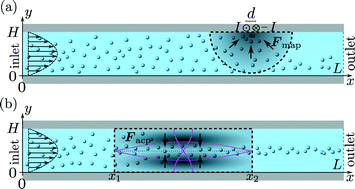Continuum modeling of hydrodynamic particle–particle interactions in microfluidic high-concentration suspensions
Abstract
A continuum model is established for numerical studies of hydrodynamic particle–particle interactions in microfluidic high-concentration suspensions. A suspension of microparticles placed in a microfluidic channel and influenced by an external force, is described by a continuous particle-concentration field coupled to the continuity and Navier–Stokes equation for the solution. The hydrodynamic interactions are accounted for through the concentration dependence of the suspension viscosity, of the single-particle mobility, and of the momentum transfer from the particles to the suspension. The model is applied on a magnetophoretic and an acoustophoretic system, respectively, and based on the results, we illustrate three main points: (1) for relative particle-to-fluid volume fractions greater than 0.01, the hydrodynamic interaction effects become important through a decreased particle mobility and an increased suspension viscosity. (2) At these high particle concentrations, particle-induced flow rolls occur, which can lead to significant deviations of the advective particle transport relative to that of dilute suspensions. (3) Which interaction mechanism that dominates, depends on the specific flow geometry and the specific external force acting on the particles.


 Please wait while we load your content...
Please wait while we load your content...